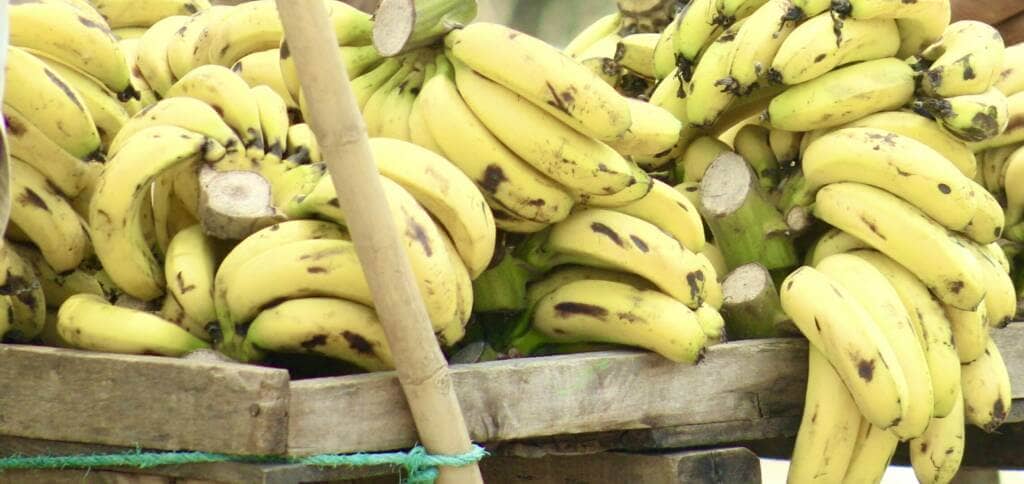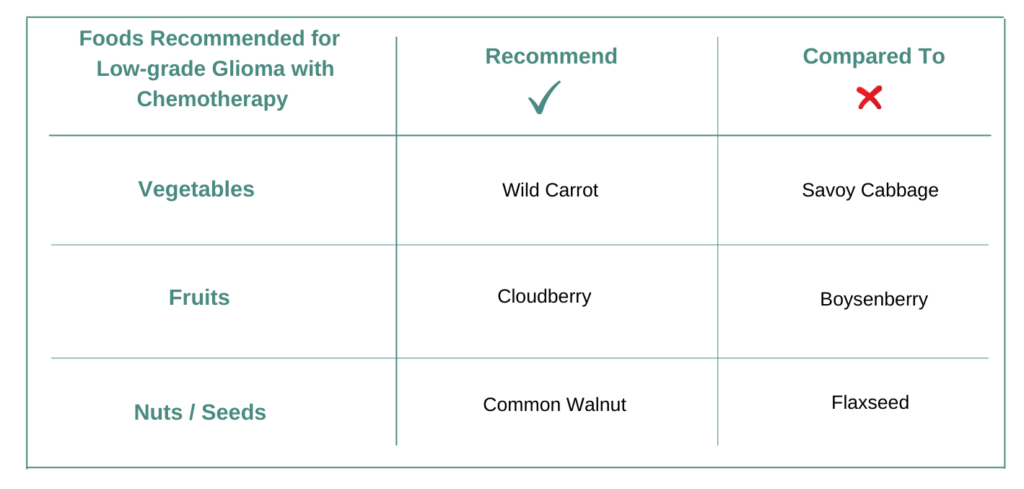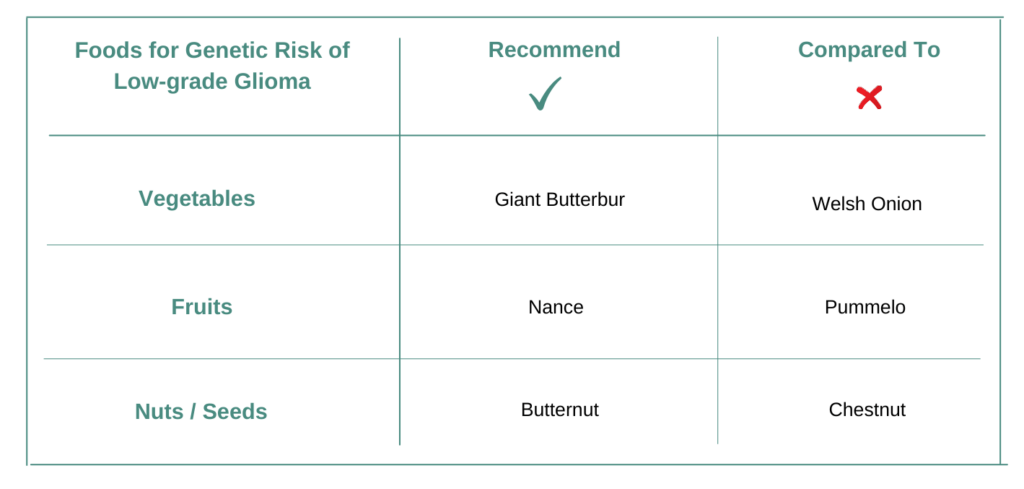Introduction
Foods for Low-grade Glioma should be personalized for each individual and also must adapt when cancer treatment or tumor genetic change. The personalization and adaptation must consider all the active ingredients or bioactives contained in different foods with respect to cancer tissue biology, genetics, treatments, lifestyle conditions and diet preferences. Hence while nutrition is one of the very important decisions for a cancer patient and individual at risk of cancer to make – how to choose foods to eat is not an easy task.
Low-grade gliomas are a type of brain tumor that grow slowly and are typically benign. They are most commonly found in adults and can have a wide range of symptoms, depending on their location in the brain. Seizures are the most common symptoms of low-grade glioma and can range in severity. Additional symptoms of low-grade gliomas include headache, personality changes, difficulty walking, imbalance, visual changes, or difficulty speaking. Gliomas form in the glial cells, the neuron-supporting cells and can develop in any part of the brain and spinal cord. MRI is the preferred imaging method for diagnosing low-grade gliomas, as it provides detailed information about the tumor’s location, size, and shape. Surgery is often the first line of treatment for low-grade gliomas, and the success rate of the procedure can vary depending on the location and type of the tumor. The life expectancy of a patient with a low-grade glioma depends on various factors, including the type and grade of the tumor, as well as the patient’s age and overall health. The recurrence rate for low-grade gliomas is generally low, but regular monitoring is recommended to ensure that the tumor does not progress to a more aggressive form. In addition, supportive care with optimal nutrition (foods and natural supplements) can improve the well-being of individuals diagnosed with low-grade gliomas.
For Low-grade Glioma does it matter what vegetables, fruits, nuts, seeds one eats?
A very common nutrition question asked by cancer patients and individuals at-genetic risk of cancer is – for cancers like Low-grade Glioma does it matter what foods I eat and which I do not? Or if I follow a plant-based diet is that enough for cancer like Low-grade Glioma?
For example does it matter if vegetable Wild Carrot is consumed more compared to Savoy Cabbage? Does it make any difference if fruit Boysenberry is preferred over Cloudberry? Also if similar choices are made for nuts/seeds like Common Walnut over Flaxseed and for pulses like Broad Bean over Pigeon Pea. And if what I eat matters – then how does one identify foods which are recommended for Low-grade Glioma and is it the same answer for everyone with the same diagnosis or genetic risk?
Yes! Foods you eat matters for Low-grade Glioma!
Food recommendations may not be the same for everyone and can be different even for the same diagnosis and genetic risk.

All foods (vegetables, fruits, nuts, seeds, pulses, oils etc.) and nutritional supplements are made up of more than one active molecular ingredient or bio-actives in different proportions and quantities. Each active ingredient has a unique mechanism of action – which can be activation or inhibition of different biochemical pathways. Simply stated foods and supplements which are recommended are those which do not cause an increase of molecular drivers of cancer but reduce them. Else those foods should not be recommended. Foods contain multiple active ingredients – hence when evaluating foods and supplements you need to consider the impact of all active ingredients cumulatively rather than individually.
For example Boysenberry contains active ingredients Curcumin, Apigenin, Daidzein, Formononetin, Delphinidin. And Cloudberry contains active ingredients Curcumin, Apigenin, Ellagic Acid, Quercetin, Daidzein and possibly others.
A common mistake made when deciding and choosing foods to eat for Low-grade Glioma – is to evaluate only selected active ingredients contained in foods and ignore the rest. Because different active ingredients contained in foods may have opposing effects on cancer drivers – you cannot cherry pick active ingredients in foods and supplements for making a nutrition decision for Low-grade Glioma.
YES – FOOD CHOICES MATTER FOR CANCER. NUTRITION DECISIONS MUST CONSIDER ALL ACTIVE INGREDIENTS OF FOODS.
Skills Needed for Nutrition Personalization for Low-grade Glioma?
Personalized nutrition for cancers like Low-grade Glioma consists of recommended foods / supplements; not recommended foods / supplements with example recipes which prioritize use of recommended foods. An example of personalized nutrition can be seen at this link.
Deciding which foods are recommended or not is extremely complicated, requiring expertise in Low-grade Glioma biology, food science, genetics, biochemistry along with good understanding of how cancer treatments work and associated vulnerabilities by which the treatments could stop being effective.
MINIMUM KNOWLEDGE EXPERTISE NEEDED FOR NUTRITION PERSONALIZATION FOR CANCER ARE: CANCER BIOLOGY, FOOD SCIENCE, CANCER TREATMENTS AND GENETICS.
Foods to Eat After Cancer Diagnosis!
No two cancers are the same. Go beyond the common nutrition guidelines for everyone and make personalized decisions about food and supplements with confidence.
Characteristics of cancers like Low-grade Glioma
All cancers like Low-grade Glioma can be characterized by a unique set of biochemical pathways – the signature pathways of Low-grade Glioma. Biochemical pathways like Growth Factor Signaling, Cell Cycle, Apoptosis, Cell Cycle Checkpoints are part of the signature definition of Low-grade Glioma. Each individual’s cancer genetics can be different and hence their specific cancer signature could be unique.
The treatments which are effective for Low-grade Glioma need to be cognizant of the associated signature biochemical pathways for each cancer patient and individual at genetic risk. Therefore different treatments with different mechanisms of actions are effective for different patients. Similarly and for the same reasons foods and supplements need to be personalized for each individual. Hence some foods and supplements are recommended for Low-grade Glioma when taking cancer treatment Capmatinib, and some foods and supplements are not recommended.
Sources like cBioPortal and many others provide population representative patient anonymized data from clinical trials for all cancer indications. This data consists of clinical trial study details like sample size / number of patients, age groups, gender, ethnicity, treatments, tumor site and any genetic mutations.
TP53, ATRX, IDH1, TERT and SETD2 are the top ranked reported genes for Low-grade Glioma. TP53 is reported in 44.4 % of the representative patients across all clinical trials. And ATRX is reported in 33.3 %. The combined population patient data cover ages from 2 to 26. 58.5 % of the patient data are identified as men. The Low-grade Glioma biology along with reported genetics together define the population represented signature biochemical pathways for this cancer. If the individual cancer tumor genetics or genes contributing to the risk are also known then that should also be used for nutrition personalization.
NUTRITION CHOICES SHOULD MATCH WITH EACH INDIVIDUAL’S CANCER SIGNATURE.
Food and Supplements for Low-grade Glioma
For Cancer Patients
Cancer patients on treatment or on palliative care need to make decisions on food and supplements – for the needed dietary calories, for managing any treatment side effects and also for improved cancer management. All plant-based foods are not equal and choosing and prioritizing foods which are personalized and customized to ongoing cancer treatment is important and complicated. Here are some examples providing guidelines for making nutrition decisions.
Choose Vegetable WILD CARROT or SAVOY CABBAGE?
Vegetable contains many active ingredients or bioactives such as Curcumin, Apigenin, Quercetin, Daidzein, Formononetin. These active ingredients manipulate various biochemical pathways like RAS-RAF Signaling, Cell Cycle, MYC Signaling and PI3K-AKT-MTOR Signaling and others. Wild Carrot is recommended for Low-grade Glioma when ongoing cancer treatment is Capmatinib. This is because Wild Carrot modifies those biochemical pathways which have been scientifically reported to sensitize the effect of Capmatinib.
Some of the active ingredients or bioactives in vegetable Savoy Cabbage are Curcumin, Daidzein, Formononetin, Delphinidin, Eugenol. These active ingredients manipulate various biochemical pathways like MYC Signaling and PI3K-AKT-MTOR Signaling and others. Savoy Cabbage is not recommended for Low-grade Glioma when ongoing cancer treatment is Capmatinib because it modifies those biochemical pathways which make the cancer treatment resistant or less responsive.
VEGETABLE WILD CARROT IS RECOMMENDED OVER SAVOY CABBAGE FOR Low-grade Glioma AND TREATMENT Capmatinib.
Choose Fruit CLOUDBERRY or BOYSENBERRY?
Fruit Cloudberry contains many active ingredients or bioactives such as Curcumin, Apigenin, Ellagic Acid, Quercetin, Daidzein. These active ingredients manipulate various biochemical pathways like RAS-RAF Signaling, MYC Signaling, Growth Factor Signaling and PI3K-AKT-MTOR Signaling and others. Cloudberry is recommended for Low-grade Glioma when ongoing cancer treatment is Capmatinib. This is because Cloudberry modifies those biochemical pathways which have been scientifically reported to sensitize the effect of Capmatinib.
Some of the active ingredients or bioactives in fruit Boysenberry are Curcumin, Apigenin, Daidzein, Formononetin, Delphinidin. These active ingredients manipulate various biochemical pathways like MYC Signaling and PI3K-AKT-MTOR Signaling and others. Boysenberry is not recommended for Low-grade Glioma when ongoing cancer treatment is Capmatinib because it modifies those biochemical pathways which make the cancer treatment resistant or less responsive.
FRUIT CLOUDBERRY IS RECOMMENDED OVER BOYSENBERRY FOR Low-grade Glioma AND TREATMENT Capmatinib.
Choose Nut COMMON WALNUT or FLAXSEED?
Common Walnut contains many active ingredients or bioactives such as Curcumin, Ellagic Acid, Quercetin, Daidzein, Formononetin. These active ingredients manipulate various biochemical pathways like RAS-RAF Signaling, Hypoxia, MYC Signaling and PI3K-AKT-MTOR Signaling and others. Common Walnut is recommended for Low-grade Glioma when ongoing cancer treatment is Capmatinib. This is because Common Walnut modifies those biochemical pathways which have been scientifically reported to sensitize the effect of Capmatinib.
Some of the active ingredients or bioactives in Flaxseed are Curcumin, Apigenin, Daidzein, Formononetin, Delphinidin. These active ingredients manipulate various biochemical pathways like MYC Signaling, Growth Factor Signaling and PI3K-AKT-MTOR Signaling and others. Flaxseed is not recommended for Low-grade Glioma when ongoing cancer treatment is Capmatinib because it modifies those biochemical pathways which make the cancer treatment resistant or less responsive.
COMMON WALNUT IS RECOMMENDED OVER FLAXSEED FOR Low-grade Glioma AND TREATMENT Capmatinib.

For Individuals with Genetic Risk of Cancer
The question asked by individuals who have genetic risk of Low-grade Glioma or familial history is “What Should I Eat Differently from Before?” and how they should choose foods and supplements to manage risks of the disease. Since for cancer risk there is nothing actionable in terms of treatment – decisions of foods and supplements become important and one of the very few actionable things which can be done. All plant-based foods are not equal and based on identified genetics and pathway signature – the choices of food and supplements should be personalized.
Choose Vegetable GIANT BUTTERBUR or WELSH ONION?
Vegetable Giant Butterbur contains many active ingredients or bioactives such as Apigenin, Curcumin, Formononetin, Lupeol, Daidzein. These active ingredients manipulate various biochemical pathways like Cell Cycle Checkpoints, MYC Signaling, Stem Cell Signaling and PI3K-AKT-MTOR Signaling and others. Giant Butterbur is recommended for risk of Low-grade Glioma when associated genetic risk is ATRX. This is because Giant Butterbur increases those biochemical pathways which counteract the signature drivers of it.
Some of the active ingredients or bioactives in vegetable Welsh Onion are Curcumin, Formononetin, Lupeol, Daidzein, Beta-sitosterol. These active ingredients manipulate various biochemical pathways like Cell Cycle Checkpoints and Stem Cell Signaling and others. Welsh Onion is not recommended when risk of Low-grade Glioma when associated genetic risk is ATRX because it increases the signature pathways of it.
VEGETABLE GIANT BUTTERBUR IS RECOMMENDED OVER WELSH ONION FOR ATRX GENETIC RISK OF CANCER.
Choose Fruit NANCE or PUMMELO?
Fruit Nance contains many active ingredients or bioactives such as Apigenin, Curcumin, Formononetin, Lupeol, Daidzein. These active ingredients manipulate various biochemical pathways like Cell Cycle Checkpoints, Hypoxia and PI3K-AKT-MTOR Signaling and others. Nance is recommended for risk of Low-grade Glioma when associated genetic risk is ATRX. This is because Nance increases those biochemical pathways which counteract the signature drivers of it.
Some of the active ingredients or bioactives in fruit Pummelo are Apigenin, Curcumin, Quercetin, Formononetin, Lupeol. These active ingredients manipulate various biochemical pathways like Hypoxia and Stem Cell Signaling and others. Pummelo is not recommended when risk of Low-grade Glioma when associated genetic risk is ATRX because it increases the signature pathways of it.
FRUIT NANCE IS RECOMMENDED OVER PUMMELO FOR ATRX GENETIC RISK OF CANCER.
Choose Nut BUTTERNUT or CHESTNUT?
Butternut contains many active ingredients or bioactives such as Apigenin, Curcumin, Formononetin, Lupeol, Daidzein. These active ingredients manipulate various biochemical pathways like Cell Cycle Checkpoints, Hypoxia, MYC Signaling and PI3K-AKT-MTOR Signaling and others. Butternut is recommended for risk of Low-grade Glioma when associated genetic risk is ATRX. This is because Butternut increases those biochemical pathways which counteract the signature drivers of it.
Some of the active ingredients or bioactives in Chestnut are Apigenin, Curcumin, Formononetin, Lupeol, Ellagic Acid. These active ingredients manipulate various biochemical pathways like Oncogenic Histone Methylation, Oncogenic Cancer Epigenetics and Stem Cell Signaling and others. Chestnut is not recommended when risk of Low-grade Glioma when associated genetic risk is ATRX because it increases the signature pathways of it.
BUTTERNUT IS RECOMMENDED OVER CHESTNUT FOR ATRX GENETIC RISK OF CANCER.

In Conclusion
Foods and Supplements chosen are important decisions for cancers like Low-grade Glioma. Low-grade Glioma patients and individuals with genetic-risk always have this question: “What foods and nutritional supplements are recommended for me and which are not?” There is a common belief which is a misconception that all plant-based foods could be beneficial or not but would not be harmful. Certain foods and supplements can interfere with cancer treatments or promote molecular pathway drivers of cancer.
There are different types of cancer indications like Low-grade Glioma, each with different tumor genetics with further genomic variations across each individual. Further every cancer treatment and chemotherapy has a unique mechanism of action. Each food like Wild Carrot contains various bioactives in different quantities, which have an impact on different and distinct sets of biochemical pathways. The definition of personalized nutrition is individualized food recommendations for the cancer indication, treatments, genetics, lifestyle and other factors. Nutrition personalization decisions for cancer require knowledge of cancer biology, food science and an understanding of different chemotherapy treatments. Finally when there are treatment changes or new genomics is identified – the nutrition personalization needs re-evaluation.
The addon nutrition personalization solution makes the decision making easy and removes all the guesswork in answering the question, “What foods should I choose or not choose for Low-grade Glioma?”. The addon multi-disciplinary team includes cancer physicians, clinical scientists, software engineers and data scientists.
Personalized Nutrition for Cancer!
Cancer changes with time. Customize and modify your nutrition based on cancer indication, treatments, lifestyle, food preferences, allergies and other factors.
References
- Brain Cptac 2020
- Tumor mutational load predicts survival after immunotherapy across multiple cancer types.
- Antiproliferative activity of daidzein and genistein may be related to ERα/c-erbB-2 expression in human breast cancer cells.
- Eugenol alleviated breast precancerous lesions through HER2/PI3K-AKT pathway-induced cell apoptosis and S-phase arrest.
- Modulation of HER2 expression by ferulic acid on human breast cancer MCF7 cells.
- Dietary D-glucarate effects on the biomarkers of inflammation during early post-initiation stages of benzo[a]pyrene-induced lung tumorigenesis in A/J mice.
- Research progress on the anticancer effects of vitamin K2.
- Effects and significance of formononetin on expression levels of HIF-1α and VEGF in mouse cervical cancer tissue.
- https://moffitt.org/cancers/low-grade-glioma/symptoms/
- https://www.ncbi.nlm.nih.gov/books/NBK560668/
- https://www.gpoh.de/kinderkrebsinfo/content/diseases/brain_tumours/pohpatinfong120070725/pohpatinfongkurz120070627/index_eng.html
